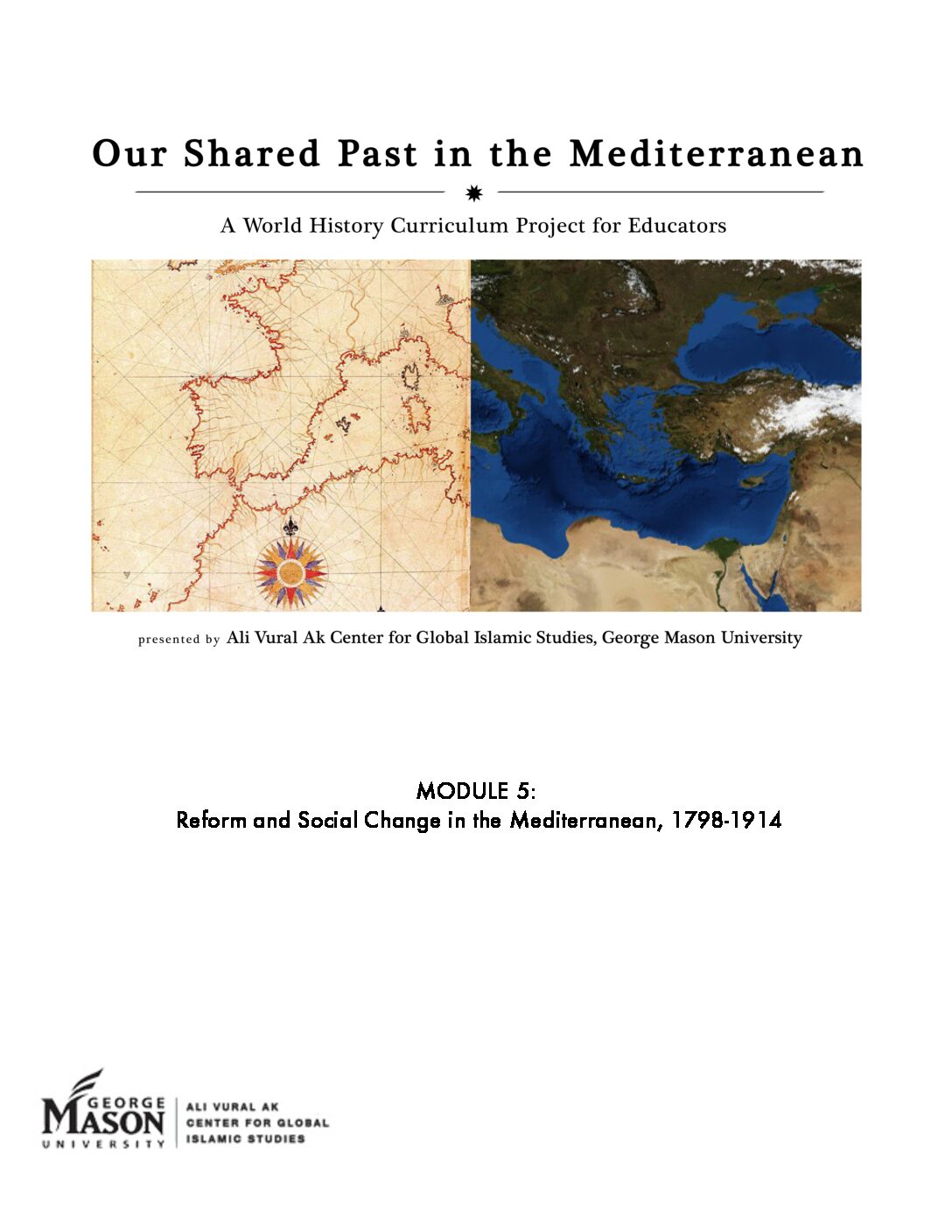Module 5: Reform and Social Change in the Mediterranean, 1798-1914
Description
During the Long Nineteenth Century, new technologies brought Mediterranean peoples closer together across time and space, while the entire region became more accessible to world commerce via the Suez Canal (1869). The industrialization of northern Europe and the political forces unleashed by the French Revolution posed a challenge throughout the Mediterranean. Failure to catch up left Mediterranean societies in all-too-close proximity to the modernized armies of the French and British empires. On the other hand, access to new ideas and technologies was just as close at hand. How Mediterranean leaders implemented far-reaching economic, political, and social reform movements is the subject of the lessons in Module 5. Students analyze a series of maps to assess the geopolitical challenges facing the Ottoman Empire; based on their findings, they write a letter to the Sublime Porte recommending and prioritizing specific reforms. Students analyze the influence of the French Revolution on the Tanzimat (or restructuring) period of Ottoman history (1839-1876), as they compare the Gulhane Proclamation (1839) to the French Declaration of the Rights of Man (1789). Portrait paintings hold the potential to connect students to the human side of history, helping them to imagine what the key players looked like, as well as how they were seen by others. For this reason, students “zoom in” to closely analyze portraits of the reformist leaders Kharyr al-Din of Tunisia, Mehmet Ali (Muhammad Ali) of Egypt and Sultan Abdulmecid I of the Ottoman Empire, presented in three PowerPoints. Afterwards students “zoom out” as they reinterpret these same images in the wider context of additional images and primary and secondary source documents. A lesson on the literary and political salons held by women (and attended by men and women) in Aleppo, Beirut, Cairo, Damascus, and Milan helps students to reflect on the multiple sources of societal change. By staging their own salon at the end of the module, students can express and assess the conflicts, progress and challenges of living through and responding to this era in the Mediterranean.Table of Contents
TEACHERS’ INTRODUCTION TO MODULE 5
MODULE 5 LESSONS
- TOPIC 1: THE NEED FOR REFORM: A STUDY IN THE GEOPOLITICS OF THE OTTOMAN EMPIRE
- Lesson 5.1: Assessing the need for Reform Through Maps
- TOPIC 2: THE CASE FOR REFORM FROM WITHIN THE OTTOMAN EMPIRE: THREE ADVOCATES
- Lesson 5.2: Three Advocates for Reform
- Lesson 5.3: Two Revolutionary Documents: A Comparison of the Proclamation of Gulhane (1839) to The Declaration of the Rights of Man (1789)
- TOPIC 3: MEHMET ALI AND REFORM IN EGYPT
- Lesson 5.4A: Portrayals of Mehmet Ali: Windows on Politics and Culture Across the Mediterranean
- Lesson 5.4B: Mehmet Ali and Reforms in Egypt
- TOPIC 4: KHAYR AL-DIN AND REFORM IN TUNISIA
- Lesson 5.5A: The Man and the Image: Groomed for Reform
- Lesson 5.5B: Man of Thought and Action.
- TOPIC 5: SULTAN ABDULMECID I AND TANZIMAT REFORMS
- Lesson 5.6A: Man on a World Stage
- Lesson 5.6B: Modern Institutions and Infrastructure: From Schools to Steamships
- TOPIC 6: WOMEN’S EMPOWERMENT AND THE TRADITION OF THE SALON
- Lesson 5.7: The Salon Heritage and its Transformation
- Lesson 5.8: Scripting/Enacting a Salon Session
ADDITIONAL LESSON MATERIALS
- World War I in the Mediterranean Region.
- World War I in the Middle East - Museum Research Project
MODULE 5 STUDENT HANDOUTS BY LESSON #

